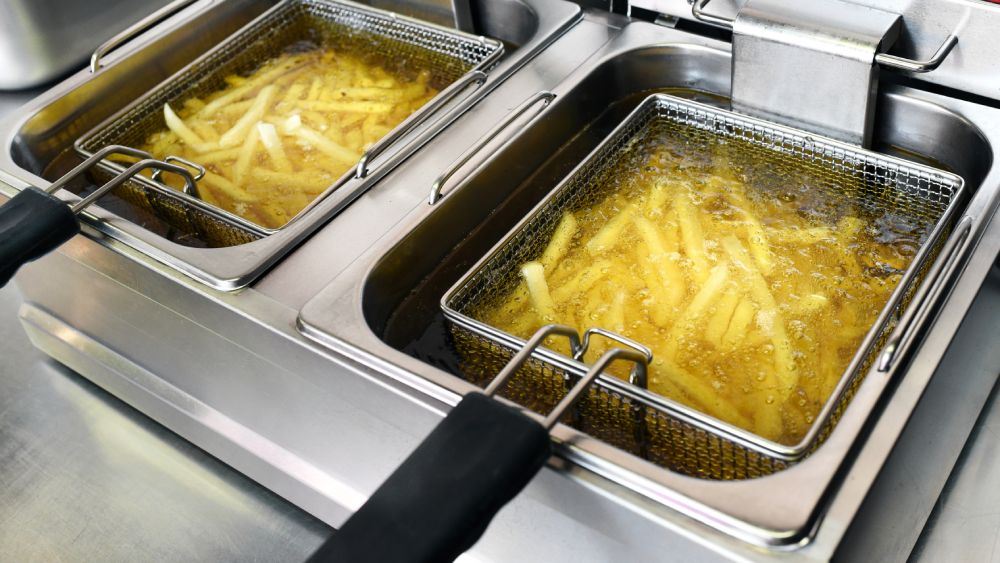
Frying Oils 101: what oils to choose for your restaurant
- What are frying oils?
- How chefs choose frying oils for their kitchen
- Types of frying oils with a high smoke point
- What oils to avoid for deep frying?
- Can you reuse frying oils?
- Tips on how to reuse frying oils
- Does cooking oil go bad?
- How to store frying oil
- How to dispose of frying oils?
- Here’s how chefs and restaurant owners can dispose of cooking oil and grease responsibly:
- Best frying oils in your area
In the culinary world, frying is a prevalent cooking method, especially in restaurant kitchens. Opting for the right type of frying oil in a commercial setting holds immense importance due to different oils’ varied flavors, textures, and smoking points. This careful selection not only influences the taste and texture of the food but also impacts resource consumption, making it a pivotal choice in culinary operations.
Here is how to choose the best frying oil for your restaurant to deliver consistent crunchy goodness while keeping your budget crisp.
What are frying oils?
The term “frying oils” refers to the types of oils used for frying, whether stir-frying, deep-frying, or sautéing. Restaurant kitchens need significant amounts of oil for large-scale frying, so choosing an oil that doesn’t strain your budget and delivers quality and flavor is essential.
Generally, frying oils are more refined, while unrefined oils have a lower smoke point, a shorter lifespan, and are best used raw.
How chefs choose frying oils for their kitchen
The importance of good frying oil cannot be understated – a wrong choice can impact both your food and your budget. Here are some key aspects to consider when you choose frying oils for your restaurant.
Smoke Point
Choosing an oil that can withstand high temperatures without smoking is important when frying. A high smoke point (350-400°F) will prevent the oils from burning and releasing unpleasant fumes that can easily ruin your food.
Stability
An oil’s stability is just as important. Certain types of oil start breaking down sooner when used for frying, causing chemical reactions that produce harmful byproducts. This can impact not just the taste of the food but also its nutritional value.
Flavor
Some frying oils have a neutral flavor, while others are more intense and can influence the taste of your food. Consider whether you need to add an extra layer of flavor or your dish is better off with a mild-tasting frying oil.
Cost
Restaurant kitchens are big consumers of frying oils, so making an affordable choice without cutting down on quality is essential. Buying oil in bulk is the best way to save money while ensuring you have enough supplies for all your frying activities.
Quality
Some frying oils are rich in healthy monosaturated fats, while others are higher in saturated fats. To add more value to your dishes, be mindful of how various oils can impact health.
Types of frying oils with a high smoke point
With a large variety of frying oils on the market, it’s helpful to know more about each type’s different flavors, smoking points, and applications to determine what works best for your kitchen.
Here are the most commonly used high smoke point cooking oils in restaurant kitchens:
Vegetable Oil
With a high smoke point of 400-450°F and a neutral flavor, vegetable oil is a great all-rounder and a safe choice for deep frying. It is usually sold as a blended oil containing a mix of plant-derived oils, such as sunflower, corn, or soybean, to provide a stable frying oil at an affordable price.
Avocado Oil
Pressed from the pulp of fresh avocados, this oil boasts a remarkable smoke point of 480°F-520°F, rendering it an ideal choice for various high-heat cooking methods. Abundant in monounsaturated fats, avocado oil imparts a mild taste with a hint of sweetness, subtly enhancing dishes with its avocado flavor profile. However, its higher price positions it as one of the less affordable oils available.
Corn Oil
Corn oil is one of the most used for frying, thanks to its high smoke point of 450°F and meager price. It imparts a slightly sweet flavor to dishes. When bought in bulk, corn oil stands out as one of the most cost-effective options available.
However, corn oil is not the healthiest option due to its high concentration of polyunsaturated omega-6 fats and lack of nutrients.
Canola Oil
With its neutral flavor and low price point, canola is another popular oil among chefs. It has a smoke point of 400-450°F. It works very well for general-purpose frying and is ideal for a pan of fried potatoes. It is one of the cheapest cooking oil options.
Peanut Oil
Peanut oil is one of the best choices for deep frying, offering a high smoke point of 448-475°F and a sweet, subtly nutty flavor. It is slightly more expensive than vegetable oils, making it a great restaurant choice.
Remember that peanut allergies are growing more prevalent, so it’s best not to rely solely on peanut oil for frying.
Coconut Oil
Coconut oil can be either virgin or refined. Virgin coconut oil has a more intense coconut flavor, while refined varieties are more neutral. Coconut oil has a lower smoke point than other oils on the list (350°F), but it works wonderfully for frying certain dishes that benefit from its flavor.
Safflower Oil
Safflower oil is perfect for various high-heat cooking methods. Its neutral flavor and high smoke point of 440-450°F make it a versatile cooking oil suitable for various dishes. Opt for the high oleic version specifically for deep frying.
What oils to avoid for deep frying?
Deep frying involves high temperatures and large quantities of oil. Not all oils are created equal, so here is what to remember if you reach for these oils when deep frying.
Grapeseed oil
With a neutral flavor and many health benefits, grapeseed oil is a high-quality option for all-around high-heat cooking. Its high price point makes it an expensive option for deep frying and reserved for pan-frying dishes.
Olive Oil
Olive oil, whether virgin or extra-virgin, is a healthy option and one of the most popular. However, its low smoke point of 325-375°F makes it suitable only for sautéing and light frying. Keep the olive oil for pan frying and salad dressings.
Other unrefined oils
Usually, unrefined oils have a lower smoke point and higher instability. Varieties like flaxseed, walnut, hazelnut, or almond oil are best used raw, so you can preserve their health benefits and flavor without burning them and wasting money.
Can you reuse frying oils?
The lifespan of your frying oils will depend on several factors, including the oil type, cooking temperature, and the duration of usage.
In restaurants, chefs often reuse frying oils to save money and minimize waste. If handled properly, oils can maintain their properties and break down slowly, allowing you to make the most out of your cooking oils.
Tips on how to reuse frying oils
Oil needs extra attention if you want to reuse it. To understand how to maximize the lifespan of cooking oils, look at the main factors that cause frying oil breakdown.
- Heat – use a thermometer to check temperatures in your fryer or pan. High temperatures contribute to oil breakdown, so choosing oils with a high smoke point for deep-frying is essential.
- Food – food particles and crumbs will ruin your oil and affect the taste of fried food. Make sure to filter your cooking oils daily. Using a filter will get rid of all impurities and prevent oil breakdown.
- Sunlight – oils are sensitive to sunlight and must be stored in dark places. If left in the fryer overnight, it should be covered.
- Salt – breaks down in oil, so it’s best to add it after frying. Drain brined items properly before frying.
Does cooking oil go bad?
No matter how well you maintain frying oils, they will go bad at one point.
How can you tell if your oil is no longer usable:
- It smells off – degraded oil will change its smell. If you notice any hint of unpleasantness, it’s time to change the oil.
- It tastes bad – a taste test can clarify whether your frying oil has gone rancid. Look for a sharp, sour, or pungent taste.
- It looks different – any signs of cloudiness can indicate your oil is rancid. Make sure to check its consistency and appearance regularly.
How to store frying oil
When storing frying oil, keeping it in an airtight container away from direct sunlight and heat sources such as ovens and stoves is important. Additionally, labeling the containers with the date and type of oil can help you keep track of their freshness.
How to dispose of frying oils?
Effectively managing and disposing of used frying oil or cooking grease is vital for maintaining a safe and healthy kitchen environment. Avoiding the mistake of pouring grease down the drain is crucial, as it can result in clogged pipes and sewer backups. Properly handling restaurant grease is essential, not only for the well-being of your staff but also for meeting local regulations.
Here’s how chefs and restaurant owners can dispose of cooking oil and grease responsibly:
1. Through Friendly Recycling:
Transforming used cooking oil into biodiesel offers a significant environmental advantage. This renewable energy source reduces waste and powers vehicles and machinery. Many cities facilitate recycling programs for used cooking oil, promoting sustainability. By checking these programs or specialized companies in your area, you can contribute to a greener future while complying with eco-friendly initiatives.
2. Complying with Local Regulations:
Before disposing of any restaurant grease, it’s crucial to understand and adhere to local regulations. For smaller operations or cooking tasks, collect the grease in a sealable container, such as a metal can or plastic jug, and dispose of it in the trash. Each region might have specific guidelines on proper disposal methods. Ensuring compliance avoids potential fines and protects public health and the environment.
3. Community Engagement and Giving Back:
Consider donating used cooking oil to organizations like animal shelters or farms. This act not only reduces waste but also supports community initiatives. Your contribution could be a valuable animal food supplement or assist in machinery lubrication. It’s a small yet impactful way to give back to the community and reduce environmental impact simultaneously.
4. Maintaining Health, Safety, and Efficiency:
Improper cooking oil disposal can lead to clogged pipes and potential environmental hazards. To avoid these issues, regularly filter fryer oil to remove impurities. When the oil shows signs of degradation—lower smoking point, darker color, or off-putting odors—promptly change it and boil out the fryer. Additionally, ensure proper storage of used oil in airtight containers away from heat and sunlight to maintain its quality.
Best frying oils in your area
Are you searching for a reliable bulk frying oil provider in New York? Look no further than Valley View Produce! As one of the most reputable wholesale produce suppliers across NYC’s five boroughs, Jersey City, Hoboken, West New York, and Weehawken Township, we offer a wide range of frying oils that cater to all your budgeting and cooking needs.
But that’s not all! We also provide a comprehensive range of restaurant supplies, including fruits and vegetables, specialty items, meats and dairy, pantry staples, and food service supplies. With Valley View Produce, you can quickly fulfill all your restaurant needs in one place!
Moreover, we value your time, so we ensure your order is delivered the next day. So, what are you waiting for? Start your online order today and get the best frying oils for your restaurant!





